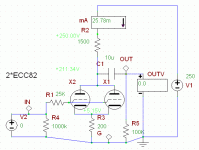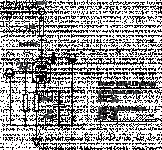Hi,
Assuming this is a circuit meant for a preamp, I'd like to add the following general comments:
Do not use paralleled sections of a twin triode unless you have no choice and are willing to select the tubes for the best possible match between triode halves.
With modern high output sources such as CD you really don't need a preamp even though everyone seems psychologically stuck on the concept.
So, use a low to medium mu triode so you don't have to burn off excessive gain and still have low enough output impedance to drive the amplifier's input.
A 12B4A is a cheap as dirt and is a single low-mu triode that sounds absolutely gorgeous.
Another possibility is to triode strap a EL84/6BQ5; it then becomes almost a 12B4A.
Then there's the *SN7 and family if you like that kind of sound and lots of other tubes with endless variations from the simplest anode follower to the most complex stack of valves....
If it must be a ECC82 and you want to put both triode sections to good use, make a SRPP stage with it: gain will be half the mu of a single section.
Output impedance will be low enough for driving all but the funniest loads.
Linearity is greatly improved BUT it will need a very good PS (everything actually does but this one's mandatory) as PSRR isn't the totem poles greatest feature.
Other than that it's all in the art of the execution and the loving hand of the master...
BTW, there's plenty of linestages to be found on this forum already. All you need is to browse through the older pages.
Cheers, 😉
Could you please comment.
Assuming this is a circuit meant for a preamp, I'd like to add the following general comments:
Do not use paralleled sections of a twin triode unless you have no choice and are willing to select the tubes for the best possible match between triode halves.
With modern high output sources such as CD you really don't need a preamp even though everyone seems psychologically stuck on the concept.
So, use a low to medium mu triode so you don't have to burn off excessive gain and still have low enough output impedance to drive the amplifier's input.
A 12B4A is a cheap as dirt and is a single low-mu triode that sounds absolutely gorgeous.
Another possibility is to triode strap a EL84/6BQ5; it then becomes almost a 12B4A.
Then there's the *SN7 and family if you like that kind of sound and lots of other tubes with endless variations from the simplest anode follower to the most complex stack of valves....
If it must be a ECC82 and you want to put both triode sections to good use, make a SRPP stage with it: gain will be half the mu of a single section.
Output impedance will be low enough for driving all but the funniest loads.
Linearity is greatly improved BUT it will need a very good PS (everything actually does but this one's mandatory) as PSRR isn't the totem poles greatest feature.
Other than that it's all in the art of the execution and the loving hand of the master...
BTW, there's plenty of linestages to be found on this forum already. All you need is to browse through the older pages.
Cheers, 😉
Ack, 1500 ohm plate resistor? Who let that happen!?
Drop at least half the supply volts in a stage, wherever possible.
Tim
Drop at least half the supply volts in a stage, wherever possible.
Tim
fdegrove said:Assuming this is a circuit meant for a preamp, I'd like to add the following general comments:
Do not use paralleled sections of a twin triode unless you have no choice and are willing to select the tubes for the best possible match between triode halves.
With modern high output sources such as CD you really don't need a preamp even though everyone seems psychologically stuck on the concept.
So, use a low to medium mu triode so you don't have to burn off excessive gain and still have low enough output impedance to drive the amplifier's input.
Yes, 100%.
Think headroom, not gain. Only use what you need.
Yes. See below.A 12B4A is a cheap as dirt and is a single low-mu triode that sounds absolutely gorgeous.
Not quite. It has a gain of about 15-20 depending on how you load it.Another possibility is to triode strap a EL84/6BQ5; it then becomes almost a 12B4A.
Attachments
Hi!🙂
It's ok to use right equipement only where needed, but can someone tell me exactly how unmatched halves sections affect the working? I am thinkin about parallel sections to improve drive capacity, or in power stage...😕
I heard about trouble with grid current...
It's ok to use right equipement only where needed, but can someone tell me exactly how unmatched halves sections affect the working? I am thinkin about parallel sections to improve drive capacity, or in power stage...😕
I heard about trouble with grid current...
Hi,
When unmatched sections are parallelled current "hogging" occurs.
This means that one half of the //ed tube will draw more current than the other leading to instability in operation parameters.
IOW, this "newly made" valve will not behave as expected as it would by merely averaging the electrical data of two equal sections or identical valves.
Add to that the fact that valves will age, hence change their electrical parameters differently from each other_especially so where they operate in // and small differences already exist from day one_and you'll see that this isn't really recommended practice.
Cheers, 😉
but can someone tell me exactly how unmatched halves sections affect the working? I am thinkin about parallel sections to improve drive capacity, or in power stage...
When unmatched sections are parallelled current "hogging" occurs.
This means that one half of the //ed tube will draw more current than the other leading to instability in operation parameters.
IOW, this "newly made" valve will not behave as expected as it would by merely averaging the electrical data of two equal sections or identical valves.
Add to that the fact that valves will age, hence change their electrical parameters differently from each other_especially so where they operate in // and small differences already exist from day one_and you'll see that this isn't really recommended practice.
Cheers, 😉
If you absolutely must parallel the triodes, split r3 ( the cathode resistor) so that each triode has its own cathode resistor.
While the triodes in a dual triode tube are well matched, its not good practice IMHO. Better and safer to find tubes that have a lower Rp and more current capibilities if thats what your design calls for.
Just my 2 cents;
Doug
While the triodes in a dual triode tube are well matched, its not good practice IMHO. Better and safer to find tubes that have a lower Rp and more current capibilities if thats what your design calls for.
Just my 2 cents;
Doug
- Status
- Not open for further replies.
- Home
- Amplifiers
- Tubes / Valves
- Parallel ECC82 comment please

